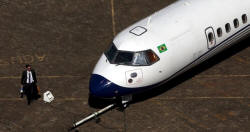|
Turboprop planemaker ATR
says enough demand to keep production stable
 Send a link to a friend
Send a link to a friend
 [September 13, 2017]
By Tim Hepher and Cyril Altmeyer [September 13, 2017]
By Tim Hepher and Cyril Altmeyer
PARIS (Reuters) - ATR, the world's largest
maker of turboprop planes, said demand in Asia and Latin America as well
as its first U.S. deal in 20 years, will help it maintain production
levels following a big drop in 2016.
ATR, which has a market share of about 75 percent of the turboprop
market, aims to produce around 80 aircraft this year and to sell at
least as many aircraft as it delivers, supported by recent deals in the
U.S. and India, according to ATR chief Christian Scherer.
In 2016, ATR's deliveries fell 9 percent to 80 units.
Speaking to the French aerospace journalists' association, Scherer
confirmed reports that ATR had won a preliminary deal to supply 20
aircraft to Fort Lauderdale-based Silver Airways, marking its first sale
to the United States in 20 years.

The three-way deal was pieced together with Nordic Aviation Capital, a
major owner of ATRs which will supply 5 of the planes with a net total
of 15 to be supplied directly by ATR and logged as fresh sales for the
planemaker when the deal is finalised.
Silver Airways is owned by Versa Capital Management.
Claiming that ATR is the world's most profitable civil plane
manufacturer, Scherer said ATR continued to deliver margins "easily in
double figures" to its shareholders - Airbus <AIR.PA> and Italian group
Leonardo <LDOF.MI>.
Revenue at ATR is expected to remain stable after falling 10 percent to
$1.8 billion last year.
SHAREHOLDERS DIVIDED
Its strong profitability in part reflects ATR's mature portfolio, though
it is expected to face pressure in coming years to invest in new fleets.
Its French and Italian shareholders have so far been divided on the
issue, with Leonardo examining possible new developments and Airbus seen
as reluctant to invest for the time being.
[to top of second column] |

A man walks past an ATR aircraft during the Latin American Business
Aviation Conference and Exhibition (LABACE) at Congonhas Airport in
Sao Paulo, Brazil, August 11, 2015. REUTERS/Paulo Whitaker

Scherer said options included a makeover of the existing line-up or new types of
plane, based either broadly on existing technology or a costlier leap in
advanced features.
No decisions have been taken, Scherer said.
ATR's main rival, Bombardier's <BBDb.TO> Q400, saw a burst of orders at the
recent Paris Airshow but continues to lag ATR.
A Bombardier executive said on Tuesday that the Canadian company would arrest
the decline in Q400 sales, Leeham News reported.
Scherer said he saw untapped potential for 300-400 turboprop sales in China in
the coming 20 years, representing a sharp boost to a global market running at
around 100 a year.
But he was cautious about short-term sales in China where few regional airlines
are winning licenses to enter the business. He said ATR planes, which are not
yet certified in China, were also hostage to wider talks between Beijing and the
European Union over mutual recognition of regulators.
Some progress is expected in coming months, he added.
ATR is meanwhile studying whether to change its formal status from Groupement
d'Interet Economique - a type of consortium under French law - to an 'S.A.'
corporation that is more widely used, but no decision is imminent, Scherer said.
(Reporting by Tim Hepher; Editing by Sudip Kar-Gupta and Elaine Hardcastle)
[© 2017 Thomson Reuters. All rights
reserved.] Copyright 2017 Reuters. All rights reserved. This material may not be published,
broadcast, rewritten or redistributed.
 |